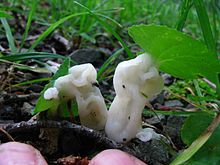Sebacina
| Sebacina | |
|---|---|
 |
|
| Varying forms of Sebacina concrescens | |
 |
|
| Scientific classification | |
| Kingdom: | Fungi |
| Division: | Basidiomycota |
| Class: | Agaricomycetes |
| Order: | Sebacinales |
| Family: | Sebacinaceae |
| Genus: |
Sebacina Tul. & C.Tul. (1871) |
| Type species | |
|
Sebacina incrustans (Pers.) Tul. & C.Tul. (1871) |
|
| Synonyms | |
Sebacina is a genus of fungi in the family Sebacinaceae. Its species are mycorrhizal, forming a range of associations with trees, orchids, and other plants. Basidiocarps (fruit bodies) are produced on soil and litter, sometimes partly encrusting stems of living plants. The fruit bodies are cartilaginous to rubbery-gelatinous and variously to coral-shaped. The genus has a cosmopolitan distribution, but less than a dozen species are currently recognized worldwide.
The genus was first published in 1871 by Louis and Charles Tulasne who had discovered that two species (Sebacina incrustans and S. epigaea) previously referred to Corticium or Thelephora possessed septate basidia, similar to those found in the genus Tremella. Although it was unusual at that time to separate fungal genera on purely microscopic characters, Sebacina was erected for effused, Corticium-like fungi with tremelloid basidia.
Many additional species were added to the genus by subsequent authors. Most, however, proved to be unrelated to Sebacina and were removed in 1957 by Ervin, who shuffled some species to Heterochaetella (for example, Heterochaetella dubia, now Stypella dubia (Bourdot & Galzin) P. Roberts), Bourdotia and Exidiopsis. In 1961, Wells also transferred many species to the genus Exidiopsis. The type species, S. incrustans, has a variable morphology, which has led to it being assigned a number of names.
Recent molecular research has shown that Sebacina is far more diverse than previously assumed, though this genetic diversity may not be reflected in morphological characters (in other words, species may be impossible to distinguish except by DNA analysis). The same research also shows that the genus splits into two groups, one clustered with the type species, the other clustered with a species sometimes referred to as "Sebacina vermifera" (though this is a misidentification). This latter species is distinct in forming thin, waxy fruit bodies and the group may not be part of Sebacina in the strict sense. Even in the strict sense, Sebacina is artificial, not being clearly distinct from related genera such as the coral-like Tremellodendron.
...
Wikipedia
